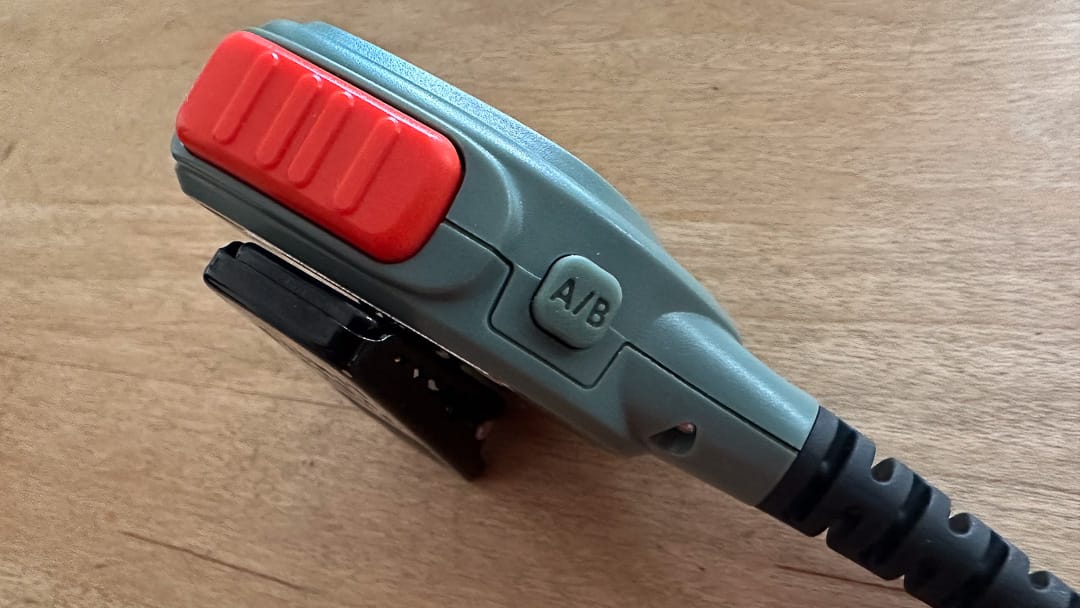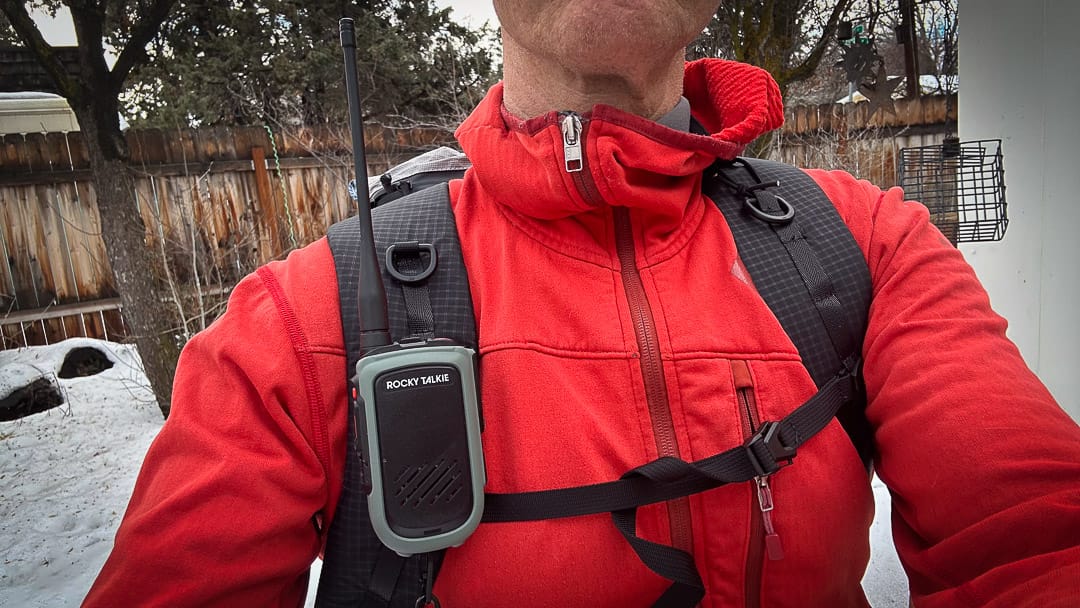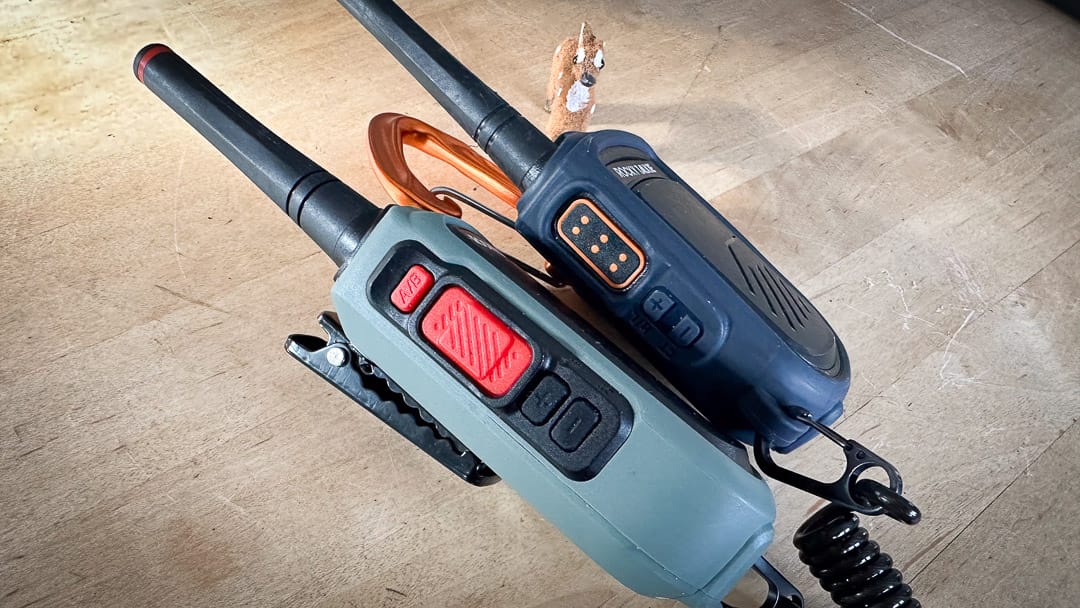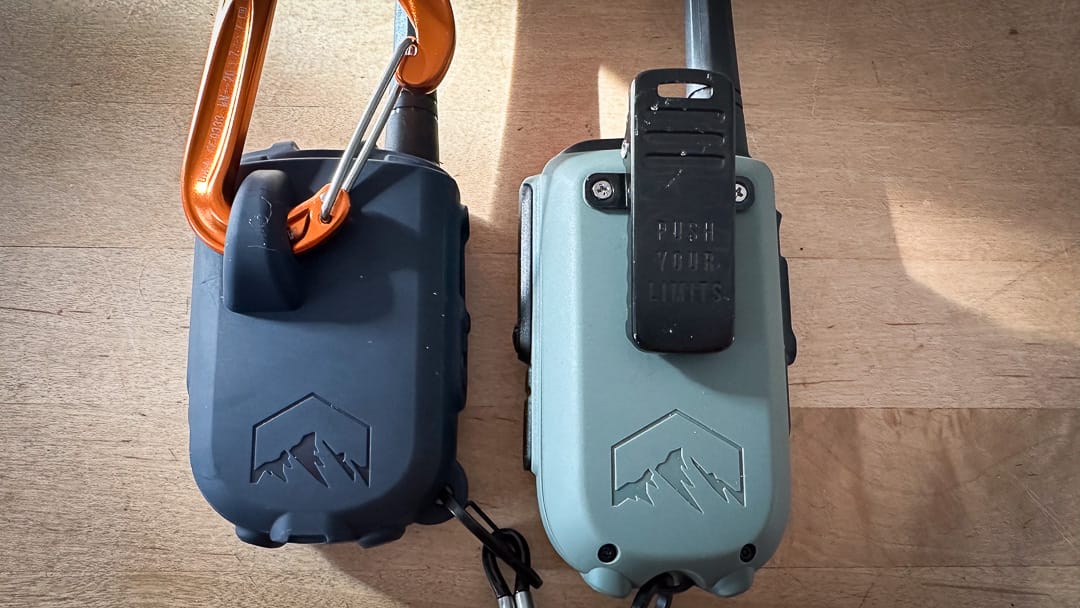
The Rocky Talkie 5 Watt Radio brings to market a relatively easy to use GMRS radio units with a feature set that may appeal to some backcountry users.
Rocky Talkie began selling the venerable 2W Mountain Radio in 2019. In a short time, the company has become known for hardened and reliable radios. I’m certain issues have befallen some units, but I’ve heard of none among my community of climbers and backcountry skiers/riders who use the radios. The Mountain Radio has been a no-nonsense functional intra-group radio for me. So far, the same is true of the 5W Radio, except it comes with a more sophisticated feature set. More on that in a minute.
The 5 Watt Radio is a GMRS (General Mobile Radio Service) radio, whereas the Mountain Radio is a FRS (Family Radio Service) radio.
Read the 5 Watt Radio first look here.
GMRS what it is and what it isn’t: Let’s jump in. FRS radios have a max power of 2 watts, so by default, they have less transmission power and less overall range. FRS radios don’t require a basic license from the FCC; a GMRS radio does. The license is easy to secure, costs $35, and lasts a decade—you can add family members to the license, so one per household should suffice.
GMRS and FRS radios share the same basic 22 channels, so if your group is on FRS radios, say, either BCA, Motorola, or Rocky Talkie, you can use the 5 Watt Radio to communicate. If your group includes several radio types, ensure you can communicate on the proper channel before heading out. (Technical note: GMRS hand radios transmit with 5W of power, but if set up to a more powerful station, like a car-mounted antenna, it’s legal to transmit at up to 50W, if it is a “fixed” station the upper limit is 15W.)

The 5 Watt Radio’s screen is shatterproof and easy to read. The photo makes the display look blurry—it is not blurry in reality. The “H” indicates the channel used is a high power channel operating at 5 watts. A channel indicating an “L” operates at 0.5 watts.
Some of the 22 channels are high power, while others are low power—for example, channel 1 on the 5 Watt Radio transmits at 5W, while channel 8 transmits at 0.5W. The Rocky Talkies (either radio version) will display an H (for high power) or L (for low power) to indicate a channel’s power output. High power channels reduce battery life faster while increasing range.
We’ve established that 5W is more powerful than 2W. Further, FRS radios have fixed antennas, while GMRS radios have interchangeable antennas. Rocky Talkie offers an add-on 17cm antenna for the 5 Watt Radio that ideally helps increase range—Rocky Talkie says the add-on antenna increases one’s ability to receive the NOAA weather channels, too. (Yes, more on that too…in a bit.) The 17cm antenna runs for $15 and is easy to swap out.
The whole GMRS 5W thing gets you more. That includes more weight. But, anyhow, it’s the “more” that might make the 5 Watt Radio preferable over an otherwise fine FRS radio.

A clean and basic interface. This shows the A/B channel toggle switch for dual channel monitoring, the transmission button, and +/- for volume control.

The hand mic (an optional accessory) has a A/B channel toggle switch for dual channel monitoring and an easy to initiate (read ample sized) transmission button while wearing a glove.
Unpacking the “More”
Weather Channels: You have access to 11 NOAA weather channels. (Access the weather channels by holding the + button on the left-hand side of the unit for a few seconds. This will default the radio to scan the 11 channels and lock on the strongest signal. You can override the scan and toggle through the channels manually.) Users can also monitor a weather channel in real-time for any emergency weather alerts. You can still listen and transmit on your set channel; the monitoring occurs in the background and only becomes audible when a weather alert is detected. According to Rocky Talkie, using the radio to monitor weather channels consumes battery juice 25% faster: Take note weather weenies.
Bottom line: A nice feature. But you probably have been eyeing weather for a while and know what the weather gods have in store. If you bring the unit on a multi-day wilderness traverse (not a hut trip), and can use repeaters or have a clean line of sight, this function could come in handy. Although you can also receive weather updates on a GPS communication device, which is lighter.
Repeaters: You can use repeaters to greatly extend the transmission range of your radio. The 5 Watt Radio comes preset to standard GMRS repeater frequencies. Repeater functionality is useful when a landform (like a mountain) obstructs proper radio communication between two parties using 5 Watt Radios, or any GMRS radio for that matter. Repeater use gets complicated for the backcountry ski enthusiast pretty damn fast. We won’t go into all the details here about how to access repeater use with the radio, but if new to repeaters, like me, read the documentation. It is more complex to use a repeater for radio communications than the simple intra-group comms most of us are used to.
Bottom line: The 5 Watt Radio allows the use of repeaters to communicate.
Dual Channel Monitoring: Love this feature. As advertised, this function allows users of the 5 Watt Radio to monitor two channels at once. This function is key for backcountry users in zones where group-to-group channels are used. On the 5 Watt Radio, setting up dual channel monitoring is easy. Setting the “B” channel is easy. Exiting and turning off dual-channel monitoring is easy. Still, dual-channel monitoring, when the secondary channel is active, meaning lots of chatter, can drain batteries faster, ~25% faster, according to Rocky Talkie.
RockyTalkie’s dual-channel monitoring is a solid option for our community. For example, you have the main channel “A” you use within your group. The “B” channel is set for the group-to-group community channel. Anytime a backcountry traveler communicates on the common “B” channel (and you are within range), you will hear the full transmission.
However, the radio has a useful function that prevents you from adding any excess chatter on the common channel. If you want to communicate on channel “B,” press the A/B button on the radio unit or the hand mic extension, and you have roughly six seconds to communicate on “B.” If you do not keep the transmission button depressed, the 5 Watt Radio defaults back to the “A” channel after six seconds. Similarly, after six seconds of inactivity, once you transmit on “B” and conclude whatever it is you need to communicate, the unit auto-switches to the “A” channel.
Just to be clear, if you have dual channel monitoring turned on, you hear any comms transmitted on both the “A” and “B” channels (you can listen in on both channels), but unless you press the A/B button to switch from channel “A” to “B,” you transmit on channel “A.”
Bottom line: I still love the dual-channel monitoring option.

Sans hand mic, the basic 5 Watt Radio unit attaches with a steel 360° rotatable gator clip. For backup security, the unit comes with a spiral leash that is easy to secure. The unit is shown here with the 17cm antenna.

As a GMRS radio, the 5 Watt Radio has the ability to swap out antennas. Here, the unit is shown with the standard 7.5cm antenna.
5 Watt Radio Thoughts
Really, so far, no gripes, only likes. The hand mic is an option I have enjoyed; it seems (maybe superficially) to keep the clutter on the shoulder straps to a minimum. I’ve also not had an issue with the Rocky Talkie Mountain Radio clipped to a shoulder strap in the past. That is to say, you have options on where you place the main body if you purchase the hand mic. The hand mic has a sizable transmit button, volume adjustments, and an A/B channel toggle switch. Using the hand mic’s transmission button is easy in a no-look and by-feel kind of way. The hand mic connects with a M3 waterproof connector, and it seems sturdy. I’ve not been delicate with the unit. I attach the hand mic to a shoulder strap and thread the spiral cord into the pack’s main compartment, where the 5 Watt Radio unit sits unsecured with the rest of my kit. Generally, a failure point for hand mics is the connection between the main unit and the hand mic. I’ve connected and disconnected the 5 Watt Radio hand mic on a near-daily basis—so far, the M3 connector works as advertised and seems durable. I like that if the M3 connector becomes compromised/fails, the main unit houses an independent mic/speaker; full functionality is retained. Side note on shoving the main unit in my pack: a switch allows locking out the settings so accidental channel switching does not occur while touring.
Battery life is touted as 4-6 days. I’ve had no battery issues. Over the holidays, I used the radio for a day of touring with normal use; I then intentionally left the unit powered up in a very cold car overnight. I used the unit the following day—a day with lots of radio chatter. We took my pal’s 11-year-old out for his first day of touring, and there were verbal shenanigans— I noticed the battery drained to ~65%. No big deal, just an observation. I default to recharging the unit when battery levels drop below 50%. The screen presents bars indicating battery strength, and upon startup, the unit displays remaining battery %. (The unit recharges with a USB-C cord.)
Is the 5 Watt Radio an unqualified upgrade compared to the Mountain Radio? I’d side with this: it is a more advanced tool designed for more advanced applications. For some backcountry folks, it might be an upgrade; for others, it might be overkill. But, if you want extra transmission power and by default, increased range, dual-channel monitoring, NOAA channels, and capacity to use repeaters, then the 5 Watt Radio it is.
The real question is determining who the 5 Watt Radio is for. Here are some things to consider for those in the this-is-not-for-me category. Weight weenies looking at the two RockyTalkie options will balk at the 5 Watt Radio’s extra mass. (But, it is more expensive than comparable FRS models, so it will lighten the wallet.) The Mountain Radio with carabiner and leash weighs 222g. Stripped down with no gator clip, the 5 Watt Radio weighs 240g—with the clip, it’s 268g. Add the hand mic to the 5 W Radio, and the weight bumps to 426g, which decreases to 408g with no gator clip.
The bump to 5W might not be needed. Users in close contact, say by a rope length/pitch, will love the Mountain Radio. For backcountry skiers/riders, the Mountain Radio, at 2W of power, has proven reliable. Generally, 2W FRS radios work in scenarios where the group sends the same above-treeline line or picks their way through a tree run. Your partners are often within or just out of eyesight. We are not discussing communicating over large distances or in zones where terrain features impede the ability to chat radio-to-radio. In my experience using 2W radios, I’ve never had a transmission fail.
Is the 5 Watt Radio an unqualified upgrade compared to the Mountain Radio? I’d side with this: it is a more advanced tool designed for more advanced applications. For some backcountry folks, it might be an upgrade; for others, it might be overkill. But, if you want extra transmission power and by default, increased range, dual-channel monitoring, NOAA channels, and capacity to use repeaters, then the 5 Watt Radio it is.
For the way I tour, I see repeaters as useful in an emergency. Is there comfort in knowing I have the option? Maybe. I can imagine ski guides in remote zones would want the ability to use repeaters.
Last week, during our local snowpocalypse then ice-rain-pocalypse , I headed out for some safe tree skiing with a partner. Later in the day, a third friend connected with us—this was his first time in the zone. I had the 5 Watt Radio with the 17cm antenna, as did the later arriving partner.
We sort of made general plans like “we’ll connect” and “try to follow the skin track” even though high winds masked skintracks minutes after they were set (even in the trees). The loose plan was to call on the radio when he left the trailhead.
He pinged me while leaving the trailhead as planned. At that point, I was about 1.25 miles away in a dense to semi-dense Hemlock forest. Where we were positioned, the mountain curved from a south to southwest aspect—there was no direct line of sight. Our radio transmissions were clear. As he skinned towards us, we could easily check in to clarify our position.
The radios worked as planned, and although not a lab environment, the extra power wasn’t a detriment.
Update: Since we published this review, RT has recalled some USB charging blocks. Here’s the brief from RT: “Our team recently identified an issue with the batch of USB Charging Blocks included with Rocky Talkie purchases since September 8, 2023. A small percentage of Charging Blocks shipped between September 8, 2023 and January 26th, 2024 were found to have an electronic component that does not meet our specifications and should not be used.”
“The issue we’ve identified occurs if you transmit with your radio while charging. In this scenario, the faulty component can overheat and fail.”
You can read the full press release here. According to the FAQs, “…your radio or house/vehicle/power bank electrical system cannot be damaged by the faulty charger component.”
Pricing
Units are sold only in the U.S. and Canada.
Price: $165 for the unit.
Rocky Talkie offers a 2-year warranty on products. Their website states, “The warranty does not cover: water damage or cosmetic damage, ie wear, tear, scuffs, scratches, or scrapes; damages caused by accident, abuse, neglect, or shock; lost or stolen items, improper use or storage of the product; unauthorized modifications or repairs.”
Included in the Box
-Single 5 Watt Radio
-360° steel gator clip
-Back-up leash
-Lithium-ion battery (replaceable) and USB-C charger
-7.5cm antenna
Price for Add-ons
Waterproof Hand Mic $65
Carabiner Loop + Attachment $15
Spare Batteries are listed on the site but are currently sold out.
Weights
5 Watt Radio w/ Gator Clip, standard antenna, and leash: 302g
5 Watt Radio stripped down (no gator clip 0r leash): 240g
Gator Clip (which is removable): 28g
5 Watt Radio Leash: 34g
5 Watt Radio handheld mic: 158g
5 Watt Radio (w/gator clip) and hand mic: 426g
5 Watt Radio (no gator clip) and hand mic: 398g
Mountain Radio with carabiner and leash: 222g
Mountain Radio stripped down (no carabiner or spiral cord): 162g




I jumped on the 5-watt bandwagon with you after your first look. I’ve been dissatisfied with the available options for years. I’ve tried:
1. Blister pack radios: cheap, but poor function and die in the wet and cold
2. BCA Gen 1: Much better than the blister pack, but the mandatory mic had channel switching issues.
3. BCA Gen 2: Fixed the channel issue, but the mic connects to the radio with a connection that breaks easily.
4. Baofeng UV5R: Nerd alert! It can talk to planes and ham radios and transmit at higher than legal power on FRS channels, but it’s just too complicated and hard to program.
So far, the 5Watt RT is a huge jump forward. I’m running it with the longer antenna, clipped to my pack with no tether or mic. It has really positive haptics, and is easy to use with gloves (mostly, see below). The battery life is superior and it’s simple. The requirement of shoulder mics on BCA radios is a liability, as I find the connection to shoulder mics a failure point. Accordingly, I stick this radio on my backpack strap and KISS. The only issues I’ve noticed with the radio so far are these:
1. The volume up button is impossible to use with a glove on because of its proximity to the transmit button bevel.
2. The scan function is slow, so if scanning, you often pick up only the second half of the transmission.
3. Biggest issue– there is no way to lock the radio in Power: Off, and it’s darn easy to turn on. You couldn’t reliably pack these in a pack and hope that they’ll stay off.
Just my 2 cents.
Thanks Patrick for the insights. So far, I’ve had the unit free floating in the main compartment (while I’m using the hand mic on the shoulder strap)—and I’ve only had the radio powered up…no accidental shut offs yet. I’m turning the radio on before I leave the house (as I do with my transceiver so I don’t space turning it on) and turning the radio off when I return to the trailhead/car.
Accidental shutoffs aren’t an issue because you can lock it in the on position, and should, as it’s pretty easy to change channels with the channel flipper. Im thinking of bringing it in to a hut or similar, for example in June I’ll be hopping a heli up to a hut in BC for some rescue training and I’ll be bringing the radio. It’ll be a bummer if it turns on in the bag, and for now I think I may just have to take the battery out for transport to guard against that.
Hey Patrick,
I have often used a hard sided sunglass case with my Baofeng radio to prevent accidental transmission in my pack – I even cut a little hole for the antenna. That might be a good solution for traveling with the rocky talkie
Let me know if I missed something. I lock out both the Mountain Radio and 5 W Radio by habit—solid for locking channel(s) in place, but I can still power down the unit when “locked.” I searched the manual before reviewing about locking in the “on” position, as that was my concern, but did not find any hints—but I certainly could have skipped passed it.